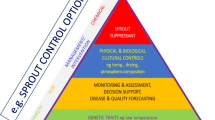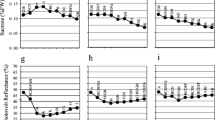Abstract
Potato storage in Great Britain is focused on delivery of high quality crops for premium markets. For the fresh sector, crops from storage need to have clean skins free from blemish. Control of black dot, silver scurf and skin spot is, therefore, paramount to secure the best returns. Cold storage is used as a primary means of suppressing disease development and sprout growth. Recent work on black dot has also illustrated the importance of the time the crop spends in the ground (measured as crop duration from 50% emergence to harvest) in relation to the level of disease at harvest, with rapid reduction in storage temperature providing best control of the disease once in store. Storage for processing is carried out at higher temperature with the use of CIPC for sprout suppression. Optimisation of the application process has been a primary objective to maintain frying quality and ensure compliance with new legislation on residue levels. The addition of a catalytic converter to a CIPC fogger minimised any detrimental effect of the fogging process on fry colour. The use of CIPC, where the application of fog has been assisted by slow speed ventilation, has proved to be very successful in trials carried out over 3 years in bulk stores. This has resulted in more uniform sprout control across the store and the need for less CIPC per season. Computerised control systems offer close regulation of storage temperature which reduces the likelihood of condensation that can otherwise compromise crop quality. AssiStore™—a new risk-driven decision support system developed at Sutton Bridge for store managers—is now being evaluated in commercial storage. Whilst development of enhanced management and control remains a key element of storage improvement strategies, it must be remembered that the important aspect of any control system is to ensure the interface with the operator is sound to ensure that any system is meaningful and easy to use. PCR diagnostics also offer great potential for identifying likely storage risks at harvest more accurately; a new test for skin spot has just been successfully developed. As storage becomes more sophisticated, costs inevitably increase. These have been recouped in recent years through improved quality delivered from store. But now there is a need to apply new, more sustainable approaches in order to lower inputs and reduce losses. Developments include the use of inverter drives to match ventilation (and hence energy needs) to demand, and humidification which offers scope for lowering weight loss and providing adiabatic cooling. Reduced reliance on chemicals is also needed and, whilst the adoption of ethylene for fresh market storage has been a significant step forward in recent years, it remains likely that the plant breeders will offer the most sustainable and cost-efficient route to effective storage in the longer term.




Similar content being viewed by others
References
Briddon A, McGowan G, Jina A, Cunnington AC, Duncan HJ (2005) Developments in CIPC application and its effects on processing quality. In: Abstracts of papers and posters, volume I. 16th European Association for Potato Research Triennial Conference, Bilbao,Spain, 17–22 July 2005, pp 364–365
Cunnington AC, Northing P, Spicer MJ, Peters JC, Briddon A (2007) AssiStore™ – a decision support system for potato store management. In: Abstracts of papers and posters, 4th EAPR/FNK/UEITP Potato Processing Conference and EAPR Engineering & Utilisation Section Meeting, Grantham, United Kingdom, 17 January 2007, pp 34–35
Daniels-Lake B, Prange RK, Nowak J, Asiedu SK, Walsh JR (2005) Sprout development and processing quality changes in potato tubers stored under ethylene. Am J Potato Res 82:389–397
de Lacy Costello BPJ, Evans P, Ewen RJ, Gunson HE, Ratcliffe NM, Spencer-Phillips PTN (1999) Identification of volatiles generated by potato tubers (Solanum tuberosum var. Maris Piper) infected by Erwinia carotovora, Bacillus polymyxa and Arthrobacter sp. Plant Pathol 48:345–351
Hardy CE, Burgess PJ, Pringle RT (1997) The effect of condensation on sporulation of Helminthosporium solani on potato tubers infected with silver scurf and held in simulated store conditions. Potato Res 40:169–180
Hilton AJ, Blackwood JM, Clayton RC (2002) The effect of temperature and duration of condensation on infection of potatoes by Fusarium coeruleum, Phoma foveata and Polyscytalum pustulans. In: Proceedings of the Crop Protection in Northern Britain Conference, Dundee, 2002, pp 317–322
Peters JC, Lees AK, Cullen DW, Sullivan L, Stroud GP, Cunnington AC (2008) Characterisation of Fusarium spp. responsible for causing dry rot of potato in Great Britain. Plant Pathol 57:262–271
Stroud GP, Coughlan K, Peters JC (2007) Evaluating the efficacy of a screen humidity cell in filtering pathogens and other particulates out of air in potato stores. In: Abstracts of papers and posters, 4th EAPR/FNK/UEITP Potato Processing Conference and EAPR Engineering & Utilisation Section Meeting, Grantham, United Kingdom, 17 January 2007, pp 23–24
Author information
Authors and Affiliations
Corresponding author
Rights and permissions
About this article
Cite this article
Cunnington, A.C. Developments in Potato Storage in Great Britain. Potato Res. 51, 403–410 (2008). https://doi.org/10.1007/s11540-008-9113-2
Received:
Accepted:
Published:
Issue Date:
DOI: https://doi.org/10.1007/s11540-008-9113-2




